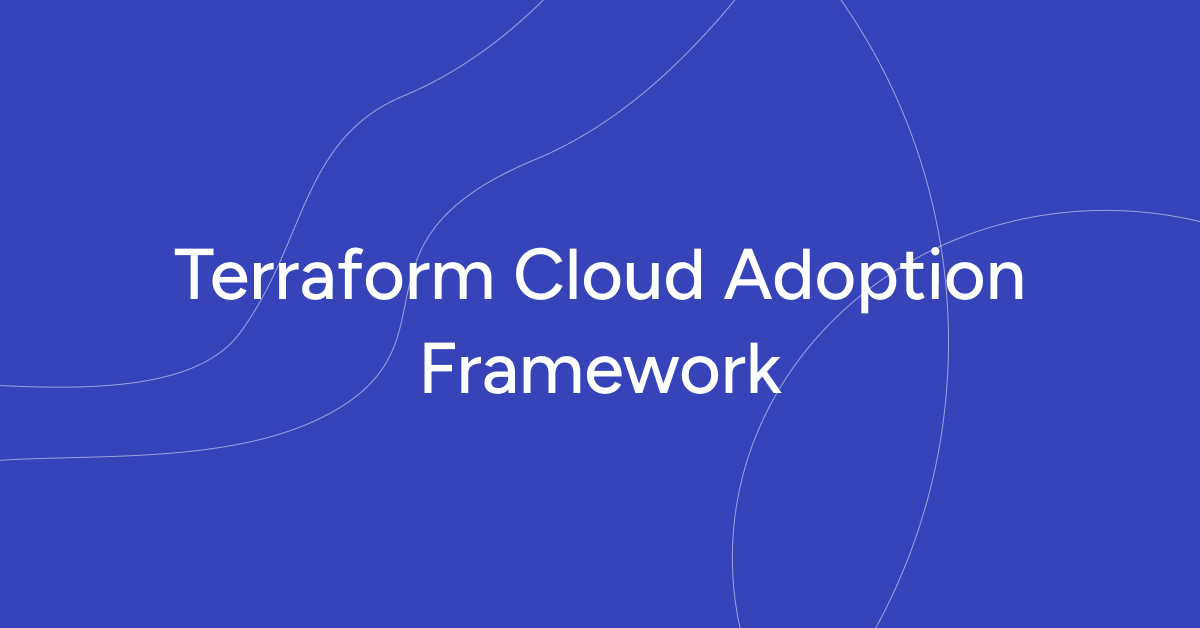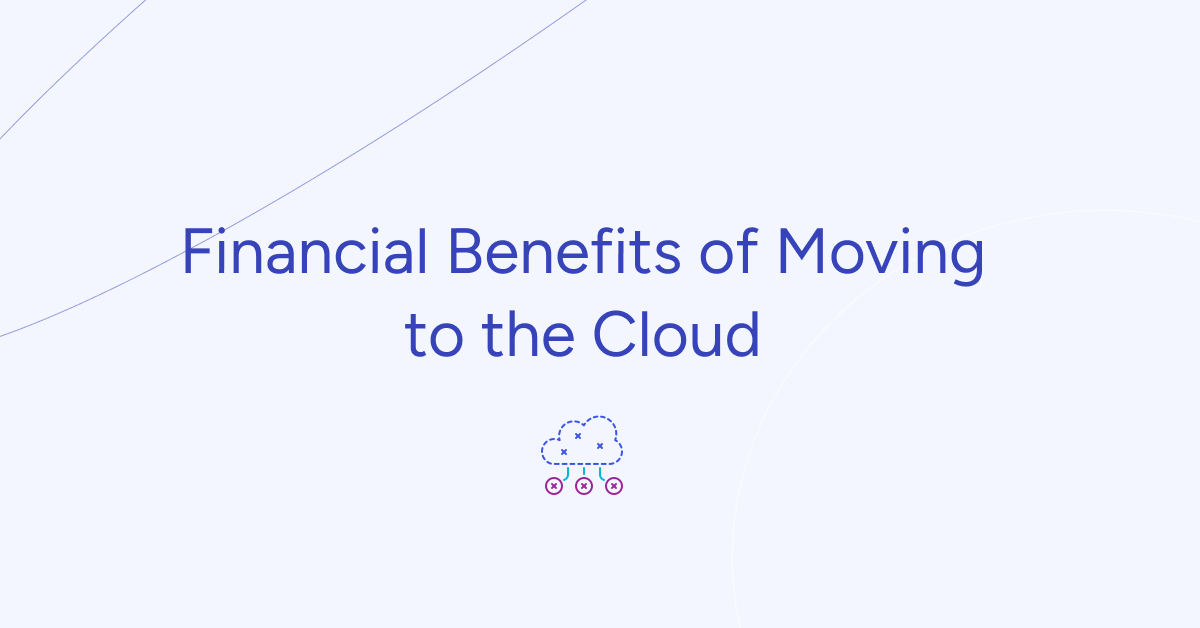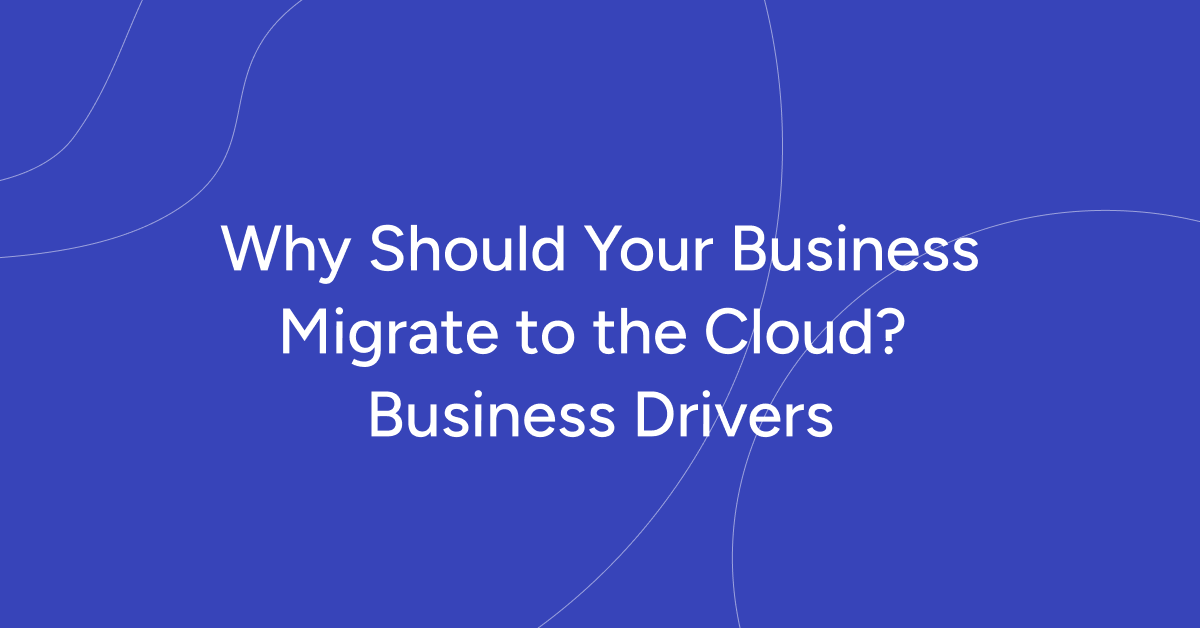Cloud adoption is a crucial consideration for many enterprises. With the need to migrate from on-premises infrastructure to the cloud, businesses seek effective frameworks to streamline this transition. One such framework gaining traction is the Terraform Framework.
- Background and Adoption Strategy
- Understanding the Azure Cloud Adoption Framework (CAF)
- Understanding the Communication between Levels
- Simplifying Infrastructure Deployments
- Streamlining Service Composition and Environment Delivery
- Organizing Teams and Repositories
- Separation of Logic and Configuration
- Empowering Application Teams
- Standardization and Unification
- Challenges and Considerations
- Conclusion: Azure Cloud Adoption Framework
This article delves into the details of the Terraform Framework and its significance, particularly for enterprise-level cloud adoption projects. We will explore the background behind its adoption, the Cloud Adoption Framework for Microsoft, the concept of landing zones, and the four levels of the Terraform Framework.
Background and Adoption Strategy
Many large enterprises face the challenge of migrating their infrastructure from on-premises environments to the cloud. In response to this, Microsoft developed the Cloud Adoption Framework (CAF) as a strategic guide for customers to plan, adopt, and implement cloud services effectively.
Let’s dive deeper into the components and benefits of the Terraform Framework within the Cloud Adoption Framework.

Understanding the Azure Cloud Adoption Framework (CAF)
The Cloud Adoption Framework for Microsoft (CAF) is a comprehensive framework that assists customers in defining their cloud strategy, planning the adoption process, and continuously implementing and managing cloud services. It covers various aspects of cloud adoption, from migration strategies to application and service management in the cloud. To gain a better understanding of this framework, it is essential to explore its core components.
Landing Zones
A fundamental component of the CAF is the concept of landing zones. A landing zone represents a scaled and secure Azure environment, typically designed for multiple subscriptions. It acts as the building block for the overall infrastructure landscape, ensuring proper connectivity and security between different application components and even on-premises systems. Landing zones consist of several elements, including security measures, governance policies, management and monitoring services, and application-specific services within a subscription.
CAF and Infrastructure Organization
The Microsoft documentation on CAF outlines different approaches to cloud adoption based on the size and complexity of an organization. Small organizations utilizing a single subscription in Azure will have a different adoption approach compared to large enterprises with numerous services and subscriptions. For enterprise-level deployments, an organized infrastructure landscape is crucial. This includes creating management groups and subscription organization, each serving specific governance and security requirements. Additionally, specialized subscriptions, such as identity subscriptions, management subscriptions, and connectivity subscriptions, are part of the overall landing zone architecture.
? Discover the power of Caf-Terraform, a revolutionary framework that takes your infrastructure management to the next level. Let’s dive in!
The Four Levels of the Terraform Framework
The Terraform Framework, an open-source project developed by Microsoft architects and engineers, simplifies the deployment of landing zones within Azure. It consists of four main components: rover, models, landing zones, and launchpad.
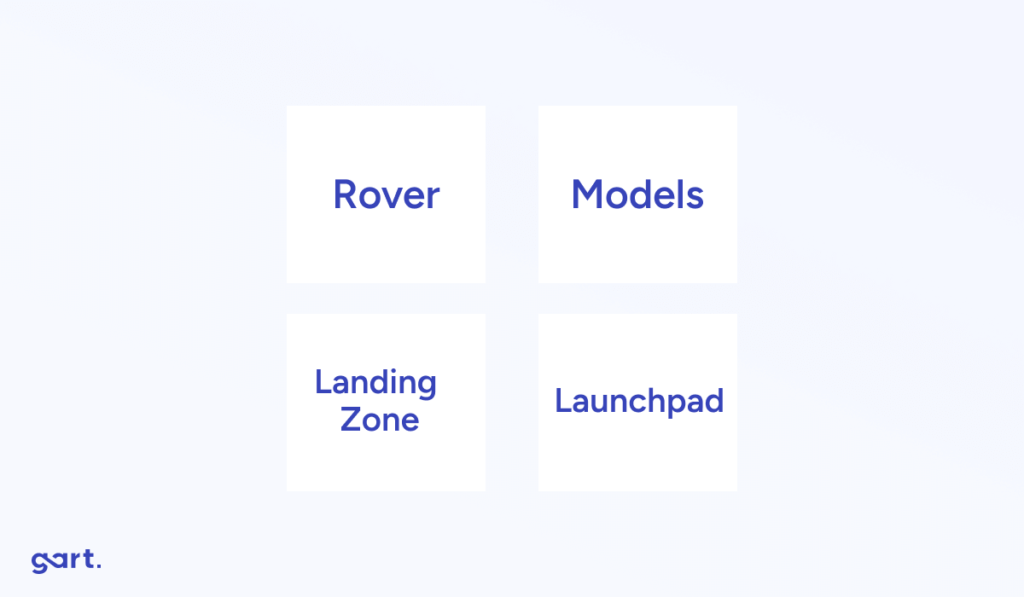
a. Rover:
The rover is a Docker container that encapsulates all the necessary tools for infrastructure deployment. It includes Terraform itself and additional scripts, facilitating a seamless transition to CI/CD pipelines across different platforms. By utilizing the rover, teams can standardize deployments and avoid compatibility issues caused by different Terraform versions on individual machines.
b. Models:
The models represent cloud adoption framework templates, hosted within the Terraform registry or GitHub repositories. These templates cover a wide range of Azure resources, providing a standardized approach for deploying infrastructure components. Although they may not cover every single resource available in Azure, they offer a strong foundation for most common resources and are continuously updated and supported by the community.
c. Landing Zones:
Landing zones represent compositions of multiple resources, services, or blueprints within the context of the Terraform Framework. They enable the creation of complex environments by dividing them into manageable subparts or services. By modularizing landing zones, organizations can efficiently deploy and manage infrastructure based on their specific requirements. The Terraform state file generated from the landing zone provides valuable information for subsequent deployments and configurations.
d. Launchpad:
The launchpad serves as the starting point for the Terraform Framework. It comprises scripts and Terraform configurations responsible for creating the foundational components required for all other levels. By deploying the launchpad, organizations establish storage accounts, keywords, and permissions necessary for storing and managing Terraform state files for higher-level deployments.
Understanding the Communication between Levels
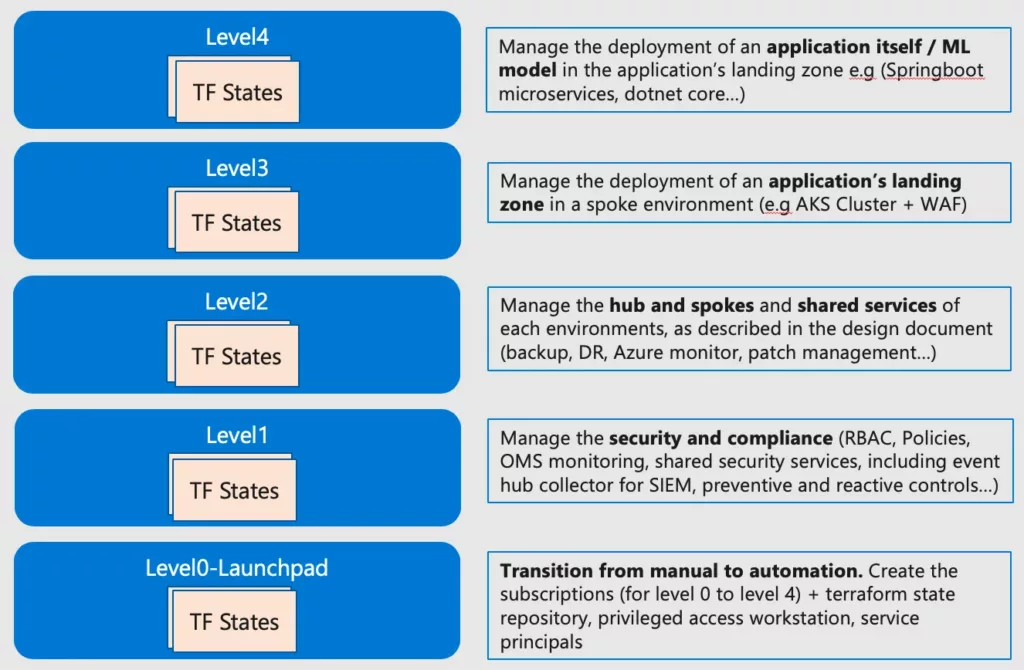
To ensure efficient management and organization, the Terraform Framework promotes a layered approach, divided into four levels:
Level Zero: This level represents the launchpad and focuses on establishing the foundational infrastructure required for subsequent levels. It involves creating storage accounts, setting up subscriptions, and permissions for managing state files.
Level One: Level one primarily deals with security and compliance aspects. It encompasses policies, access control, and governance implementation across subscriptions. The level one pipeline reads outputs from level zero but has read-only access to the state files.
Level Two: Level two revolves around network infrastructure and shared services. It includes creating hub networks, configuring DNS, implementing firewalls, and enabling shared services such as monitoring and backup solutions. Level two interacts with level one and level zero, retrieving information from their state files.
Level Three and Beyond: From level three onwards, the focus shifts to application-specific deployments. Development teams responsible for application infrastructure, such as Kubernetes clusters, virtual machines, or databases, engage with levels three and beyond. These levels have access to state files from the previous levels, enabling seamless integration and deployment of application-specific resources.
Simplifying Infrastructure Deployments
In order to create new virtual machines for specific applications, we can leverage the power of Terraform and modify the configuration inside the Terraform code. By doing so, we can trigger a pipeline that resembles regular Terraform work. This approach allows us to have more control over the deployment and configuration of virtual machines.
Streamlining Service Composition and Environment Delivery
When discussing service composition and delivering a complete environment, this layered approach in Terraform can be quite beneficial. We can utilize landing zones or blueprint models at different levels. These models have input variables and produce output variables that are saved into the Terraform state file. Another landing zone or level can access these output variables, use them within its own logic, compose them with input variables, and produce its own output variables.
Organizing Teams and Repositories
This layered approach, facilitated by Terraform, helps to organize the relationship between different repositories or teams within an organization. Developers or DevOps professionals responsible for creating landing zones or cleaning zones can work locally with the Rover container in VS Code. They write Terraform code, compose and utilize modules, and create landing zone logic.
Separation of Logic and Configuration
The logic and configuration in the Terraform code are split into separate files, similar to regular Terraform practices. The logic is stored in .tf and .tfvars files, while the configuration is stored in .tfvars files, which can be organized into different environments. This separation allows for better management and maintainability.
Empowering Application Teams
Within an organization, different teams can be responsible for different aspects of the infrastructure. An experienced Azure team can define the organization’s standards and write the landing zone logic using Terraform. They can provide examples of configuration files that application teams can use. By offloading the configuration files to the application teams, they can easily create infrastructure for their applications without directly involving the operations team.
Standardization and Unification
This approach allows for the standardization and unification of infrastructure within the organization. With the use of modules in Terraform, teams don’t have to start from scratch but can reuse existing code and configurations, creating a consistent and streamlined infrastructure landscape.
Challenges and Considerations
Working with Terraform and the Caf-terraform framework may have some complexities. For example, the Rover tool is not able to work with managed identities, requiring the management of service principals in addition to containers and managed identities. Additionally, there may be some bugs in the modules that need to be addressed, but the open-source nature of the framework allows for contributions and improvements. Understanding the framework and its intricacies may take some time due to the documentation being spread across multiple reports and components.
Key components and features of CAF Terraform:
| Component | Description |
| Cloud Adoption Framework (CAF) | Microsoft’s framework that provides guidance and best practices for organizations adopting Azure cloud services. |
| Terraform | Open-source infrastructure-as-code tool used for provisioning and managing cloud resources. |
| Azure Landing Zones | Pre-configured environments in Azure that provide a foundation for deploying workloads securely and consistently. |
| Infrastructure as Code (IaC) | Approach to defining and managing infrastructure resources using declarative code. |
| Standardized Deployments | Ensures consistent configurations and deployments across environments, reducing inconsistencies and human errors. |
| Modularity | Offers a modular architecture allowing customization and extension of the framework based on organizational requirements. |
| Customizability | Enables organizations to adapt and tailor CAF Terraform to their specific needs, incorporating existing processes, policies, and compliance standards. |
| Security and Governance | Embeds security controls, network configurations, identity management, and compliance requirements into infrastructure code to enforce best practices and ensure secure deployments. |
| Ongoing Management | Simplifies ongoing management, updates, and scaling of Azure landing zones, enabling organizations to easily make changes to configurations and manage the lifecycle of resources. |
| Collaboration and Agility | Facilitates collaboration among teams through infrastructure-as-code practices, promoting agility, version control, and rapid deployments. |
| Documentation and Community | Comprehensive documentation and resources provided by Microsoft Azure, along with a vibrant community offering tutorials, examples, and support for leveraging CAF Terraform effectively. |
Conclusion: Azure Cloud Adoption Framework
The Terraform Framework within the Cloud Adoption Framework (CAF) offers enterprises a powerful toolset for cloud adoption and migration projects. By leveraging the modular structure of landing zones and adhering to the layered approach, organizations can effectively manage infrastructure deployments in Azure. The Terraform Framework’s components, including rover, models, landing zones, and launchpad, contribute to standardization, automation, and collaboration, leading to successful cloud adoption and improved operational efficiency.
As organizations embrace the cloud, the Caf-terraform framework provides a layered approach to managing infrastructure and deployments. By separating logic and configuration and leveraging modules, it allows for standardized and unified infrastructure across teams and repositories. This framework simplifies and optimizes the transition from on-premises to the cloud, enabling enterprises to harness the full potential of Azure’s capabilities.
Empower your team with DevOps excellence! Streamline workflows, boost productivity, and fortify security. Let’s shape the future of your software development together – inquire about our DevOps Consulting Services.

